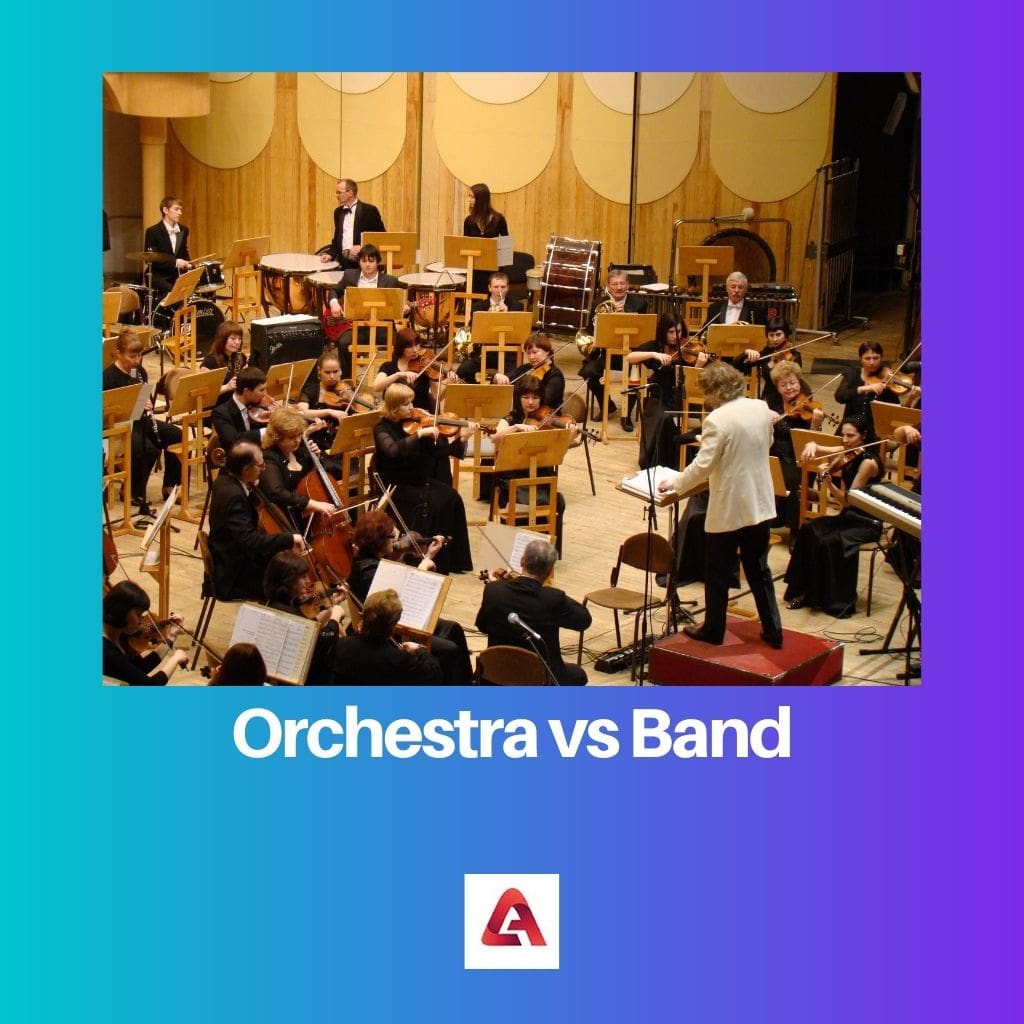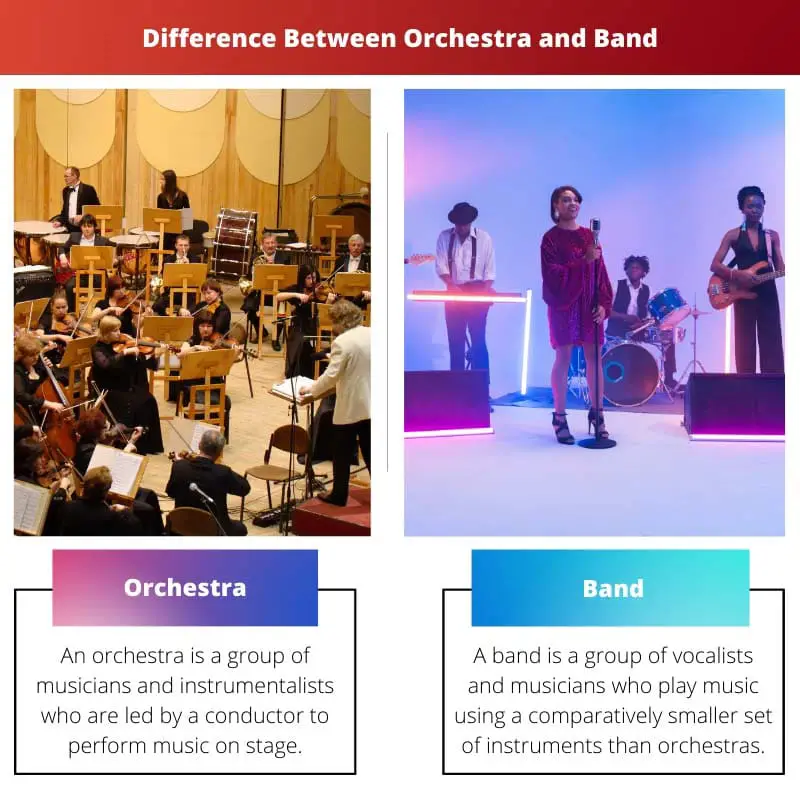An orchestra uses all families of instruments. While the violins are placed at the frontier, strings are more center stage.
Some bands may also use string instruments in their music. These are called symphonic bands.
However, the section of string instruments in bands includes just the cello, bass, piano, or harp.
Key Takeaways
- Orchestra is a large musical ensemble consisting of string, woodwind, brass, and percussion instruments, performing classical music; a band is a smaller musical group encompassing various genres, brass, woodwind, and percussion instruments.
- Orchestras are led by a conductor who coordinates and directs the musicians during performances; bands may have a leader but rely on individual musicians or sections to coordinate their playing.
- Orchestra compositions are more complex, with multiple movements and intricate arrangements; band music can be simpler, focusing on rhythm, harmony, and melody.
Orchestra vs. Band
An orchestra is a large ensemble of musicians that includes strings, woodwinds, brass, and percussion instruments and is known for playing classical music, such as symphonies and operas. On the other hand, a band is a group of musicians that includes guitars, bass, and drums and includes vocals.

The orchestra uses instruments that are divided into sections of strings, woodwinds, brass, and percussion. A conductor or music director leads the entire musical ensemble.
In contrast with orchestras, bands do not include string instruments.
Comparison Table
| Parameters of Comparison | Orchestra | Band |
|---|---|---|
| Meaning | An orchestra is a group of musicians and instrumentalists who are led by a conductor or music director to perform music on stage. | A band is a group of vocalists and musicians who play music using a comparatively smaller set of instruments than orchestras. |
| Types | Orchestras are of two types – chamber orchestras and symphony Orchestras. | Many types of bands play various genres of music. Some types of bands include concert bands, jazz bands, marching bands, Christian bands, cover bands, heavy metal bands, etc. |
| Members | An orchestra is a large group of musicians that can include even 100 or more members. | A band is a small group of musicians with fewer members than orchestras. |
| Instruments | Orchestras use four main families of instruments – strings, woodwinds, brass, and percussion. | Bands use brass, woodwind, and percussion instruments but do not use string instruments. |
| Type of music | Orchestras play Western class is music or opera. However, they sometimes even play music for modern films and concert music. | Bands play modern music of a large variety. Some include – rock, jazz, heavy metal, pop, soul, R&B, swing, funk, and much more. |
| Origin | The origin of the first orchestra dates way back to ancient Greece. However, the modern orchestra setting was put together in the 17th century. | Bands are said to be originated in the 15th century by people of Germany who used bassoons and oboes as instruments. |
What is an Orchestra?
An orchestra is a large ensemble of musicians and instrumentalists who play Western classical music or opera. The instruments used in an orchestra are from the families of strings, woodwinds, brass, and percussions.
The entire musical group is led by a conductor or music director who instructs the musicians to play music in a certain way. Orchestras can be categorized into two kinds – chamber orchestras and symphony Orchestras.
While Chamber orchestras include 50 or fewer members, symphony Orchestras can include even more than 100 members. Musical groups as large as what is now called an orchestra are known to have emerged in the 17th century, with the early development of Opera.
These orchestras used flutes, oboes, horns, trumpets, bassoons, and kettledrums. A full-scale opera currently consists of 100 permanent members who are assigned various instruments, including violins, oboes, clarinets, flutes, cellos, basses, etc.

What is a Band?
A band is a small group of musicians who play modern music using woodwinds, bass, and percussion. Usually, a band does not use instruments of the string family.
In some cases, bands that use string ( cello, bass, piano, or harp) instruments are called symphonic bands. In the 18th century, Germans formed small groups of people who played music using instruments such as bassoons and oboes.
Subsequently, in the late 18th century, such music became popular among the Turkish. Janissary music played by these Turkish people featured instruments such as drums, flutes, triangles, cymbals, etc.
During the revolutionary war in the United States, marching bands were formed. These were small groups of people who played bugles, fifes, and drums and accompanied the marching soldiers during battles.
Nowadays, marching bands are even used during parades and football games. Currently, bands play various modern music, including rock, heavy metal, pop, funk, R&B, etc.
These bands perform live on stage, as well as on radio and television. Some of the most popular bands to date include.
The Beatles, the Rolling Stones, U2, Led Zeppelin, and Pink Floyd.

Main Differences Between Orchestra and Band
- An orchestra is a group of musicians and instrumentalists led by a conductor or music director to perform music. On the other hand, a band is a group of vocalists or musicians who perform modern music on stage, radio, or television.
- An orchestra uses string instruments, while a band originally did not use any string instruments.
- An orchestra can include up to 100 or even more members, while bands include fewer people.
- Orchestras originally played Western classical music and opera. On the other hand, bands play various music, including jazz, rock, heavy metal, soul, funk, R&B, and much more.
- Orchestras are of two types – chamber orchestras and symphony orchestras. Bands can be of many types depending on the kind of music they play.



